6th Annual Salary Survey: With warehouse/DC experience comes reward
Compensation continues to climb steadily upward in the materials handling industry, which is overwhelmingly populated with satisfied veteran employees.
The results of Modern’s 6th Annual Salary Survey paint an appealing picture of employment in materials handling, even as young, new talent continues to trickle into the industry. At $95,010, the average base salary is the highest in the six years of our survey, up nearly 6% over last year’s record average. Just as with last year, an impressive 97% of the more than 735 respondents expressed satisfaction with their work.
Survey respondents represent a range of industries and disciplines, and 91% say they like their jobs. The same 91% said they would recommend the materials handling profession to others. With 55% indicating they intend to finish their careers with their current employer and with an average turnover rate of 6.7%, the industry seems to have little trouble retaining happy employees. Modest increases in the number of 18- to 34-year-olds and college graduates suggest some new blood is making its way into the industry. It will be interesting to watch the transition as the 55- to 64-year-olds (who make up 30% of the respondent base) approach retirement.
In the meantime, the use of drastic cost-saving measures like layoffs and pay cuts has declined by double digits since 2011, and hiring continues to surge. Materials handling professionals report they feel more valued in their roles as their organizations recognize the value of the supply chain to the bottom line and customer satisfaction.
A consistent theme throughout the survey’s short answer section is that each day brings a new challenge. Amid constant change, the optimism among materials handling professionals seems unmoved. (Read previous Salary Surveys)
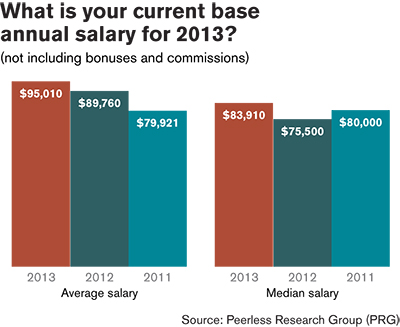
The compensation picture
Hiring saw a slight uptick in 2013 with 56% of respondents indicating their companies have been hiring in the previous 12 months. Meanwhile, respondents also reported decreased instances of layoffs, pay cuts, hiring freezes, reduced benefits and reduced overtime. As recently as 2011, almost 40% said their companies had implemented at least one of those cost reduction measures. Now it’s down to between 25% and 30%.
This year, 64% of respondents said their salary increased in the past year (6% more than in 2012) and 33% said it stayed the same (5% fewer than in 2012). In 2013, the average base salary increase was 5.2%, the same pace as 2012. Of those respondents who saw a salary increase last year, nearly one in eight received increases of 10% or more.
Bonus plans continue to reflect a focus on company and individual performance. In past years, nearly half of respondents indicated bonuses were based primarily on lower operational costs and increased sales. In 2013, lower operational costs were a source of bonuses for just 25% of respondents. And while increased sales bonuses jumped from 29% to 36%, incentives for better inventory management fell from 15% to 11%. Overwhelmingly, bonuses result from the company reaching its performance goals (67%) and individual performance (47%). As recently as 2010, those factors rang true for just 18% and 5% of respondents, respectively.
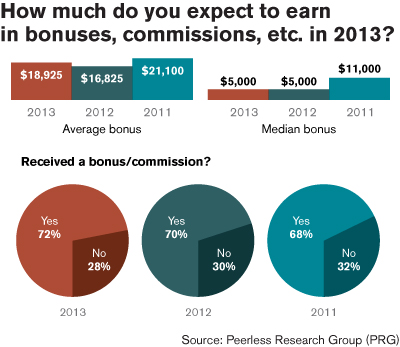
Demographics
About 14% of respondents work for companies with estimated 2012 revenues of less than $10 million. Another 19% expect between $10 million and $50 million, and 48% are larger than $250 million—including 22% above $2.5 billion.
Industries represented by respondents include food, beverage and tobacco (9%); automotive and transportation equipment (7%); wholesale trade (7%); retail trade (5%); chemicals and pharmaceuticals (5%); industrial machinery (5%); and third-party logistics (5%). Primary job functions of respondents include warehouse, distribution and logistics (31%); engineering (18%); plant management (16%); company management (13%); and purchasing (9%).
Fewer than 22% of respondents have been in the materials handling profession for less than 10 years. More than half have been at it for more than 20 years, including 17% with 30-plus years in the field. On average, those who have been in the industry less than five years can expect to earn $55,000. But, their next five years could see a 27% increase to an average of $70,000.
The average respondent age continues to hover around 51, and with experience comes better compensation. In 2009, 25% of the survey’s respondents reported earning base salaries of six figures or more. In 2013, that number rose to 32% with 10% earning $150,000 or more (up from 8% last year). Fewer employees have faced wage decreases since 2009, when one in 10 respondents saw their salaries reduced by an average of 15% year over year. Just 3% saw decreases averaging 14% in 2013.
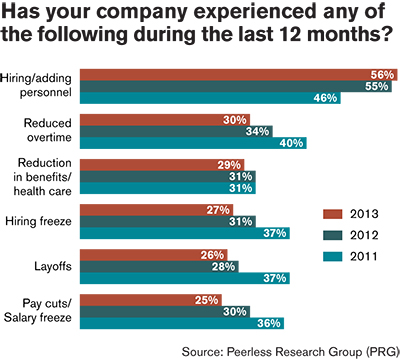
Those with supervisory responsibilities can expect to earn 30% more than their non-supervisor colleagues, as compared to the 36% gap between the two groups as captured in last year’s results. Those with budgetary responsibilities will earn about 40% more than those without. In last year’s survey, supervisor salaries increased an average of 4.5%, whereas the average salary for a non-supervisor fell by slightly more than 1%. In 2013, the average supervisor salary increased 5.5% but was dwarfed by the more than 10% increase in non-supervisor salaries. This results in an average base salary of $94,010 for 2013, a 6% increase from 2012, while the median salary jumped 11% to $83,910.
Modern’s first Salary Survey, published in June 2008, showed median compensation at $80,000 including base salary and bonuses. After that median number dipped as low as $78,000 in 2009 and 2010, it shot back up to $91,000 in 2011, only to settle back at $83,910 this year.
This year, 48% of respondents completed an undergraduate degree, up from 40% last year. Nearly half have been with their current employer for 10 years or more, with 24% having served 20 years or more.
Regionally within the U.S., there has been some localized growth in average salaries. In the south, where 12% of all respondents are employed, average salaries jumped from $83,900 to $92,030, an increase of 9.7%. In the Midwest, where 40% of respondents are located, salaries decreased by about 3% to settle at an average of $85,670.

Job satisfaction
When asked about their futures, 55% see themselves finishing their careers at their current employers. Among that group, salaries increased an average of 6.2%. Those who do not intend to finish their careers with their present employer saw average salaries increase 10%, and salaries for those who said they are “unsure” rose by 5.7%.
In 2009 and 2010, just 12% of respondents expressed they were “extremely satisfied” with their careers in materials handling, as compared to 20% in 2012. This year the number has fallen to 17%, while the percentage of those “very” or “somewhat” satisfied in 2010 rose slightly to 56% and 24% respectively. Today, just 3% are “not very” or “not at all” satisfied.
This year, 38% of respondents indicate no interest in seeking another job, down slightly from last year. The same 36% who said in 2012 they are “open to other possibilities” are still keeping their options open in 2013. About 21% are passively looking for work elsewhere and just 5% are actively looking, motivated primarily by compensation (53%), the desire for new challenges (40%), and a lack of advancement opportunities (33%).
When asked about stress levels at work, 43% say it is more stressful than two years ago, and 44% say stress levels have remained the same. Among the 10% who report their job is “extremely” stressful and the 34% whose work is “very” stressful, the top complaints included workload (47%), not enough people (41%), not enough time (40%), balancing work life and home life (37%), questionable management decisions (36%), and working with outdated technologies (29%).
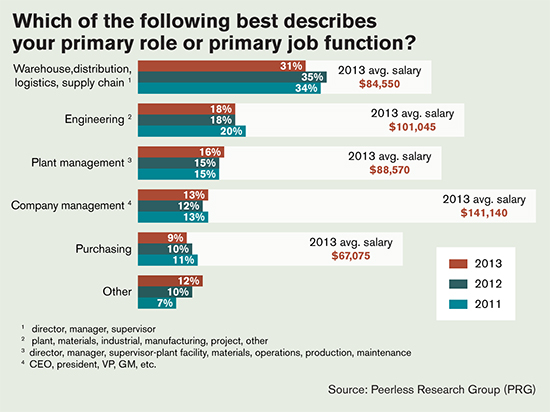
Respondents by the numbers
In September 2013, Modern Materials Handling subscribers received an e-mail invitation to participate in the 6th Annual Salary Survey. The study, performed by Peerless Research Group (PRG), received a total of 735 responses from qualified materials handling professionals.
The average respondent is a 51-year-old male earning $95,010 in salary and $18,925 in bonuses (median salary $88,910, median bonus $5,000), for a combined average increase of 6.9% over last year (median increase: 10.4%). It is worth noting that the percentage of female respondents, after falling from 12% in 2011 to 6% in 2012 is now 9%. The average base salary for women also dropped from $76,242 in 2011 to $66,635 in 2012, and now stands at $68,020.
The average respondent has a budget authority of $193,700 (median: $9,790). About 67% of respondents’ employers are manufacturing companies. The average respondent works for a company with 3,203 employees (median: 878) and an estimated annual revenue of $842 million (median: $209 million). He has worked there for 11 years of his 18-year materials handling career, during which time he has worked for 2.4 companies.
And, 78% of respondents have been in the industry at least 10 years, 51% for more than 20, and 17% have been at it for more than 30 years. For the second year in a row, 9% of respondents were personally impacted by layoffs in the previous 12 months, as opposed to 14% in 2011.
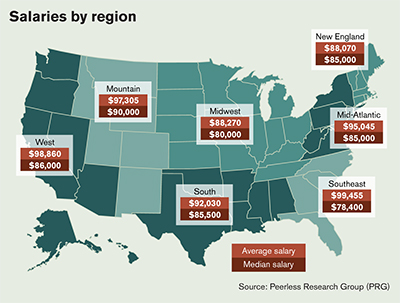

Article Topics
Special Reports News & Resources
Automation/Retail Special Issue: Savvy users embrace change Research Report: Use of Automation in Warehouse/DC Special Digital Issue: Warehouse/DC Robotics System Report: Building the world’s best warehouse Top 20 Warehouses 2019 Top 20 automatic identification and data capture suppliers 2019 Top 20 Lift Truck Suppliers in 2019: Market reaches new heights More Special ReportsLatest in Materials Handling
The (Not So) Secret Weapons: How Key Cabinets and Asset Management Lockers Are Changing Supply Chain Operations MODEX C-Suite Interview with Harold Vanasse: The perfect blend of automation and sustainability Consultant and industry leader John M. Hill passes on at age 86 Registration open for Pack Expo International 2024 Walmart chooses Swisslog AS/RS and software for third milk processing facility NetLogistik partners with Vuzix subsidiary Moviynt to offer mobility solutions for warehouses Materials Handling Robotics: The new world of heterogeneous robotic integration More Materials HandlingAbout the Author
Subscribe to Materials Handling Magazine

Find out what the world's most innovative companies are doing to improve productivity in their plants and distribution centers.
Start your FREE subscription today.
April 2024 Modern Materials Handling

Latest Resources










